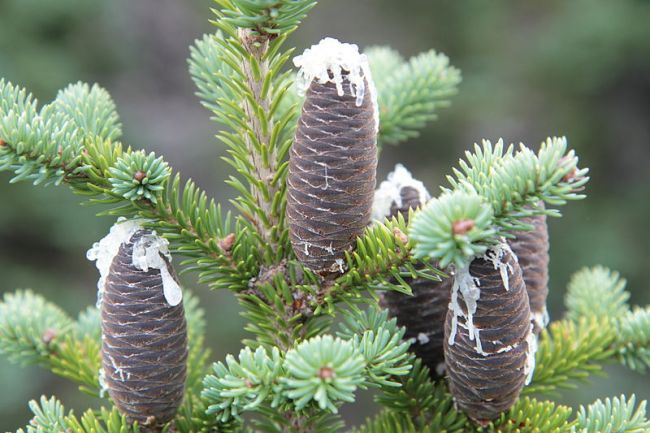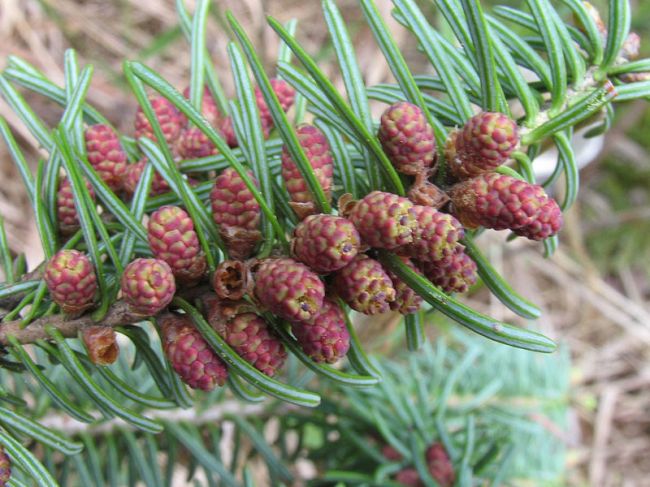For all the Balsam Fir’s flaws, it has been used popularly as a Christmas tree. The root system is fairly shallow, and growth is generally slow. Balsam Firs are unfortunately plagued with a myriad of pest and disease problems.
Abies balsamea (Balsam Fir)
Deciduous: no
Hardiness Zones: 3-6 (performs best in 3-5)
Height: 12-21 meters (40-70 feet (sometimes up to 27 meters (90 feet))) tall
Diameter: 4.5-7.5 meters (15-25 feet) across
Growth Rate: slow
Age: may begin cone production at 15 years of age, typically occurs between 20-30 years of age
Root System: typicall shallow (produces a taproot-like root system when young, however), lateral roots may spread up to 5 feet from the base, roots typically penetrate 60-75 centimeters (24-30 inches) into the soil (up to 135 centimeters (54 inches) deep)
Family: Pinaceae
Subspecies: none
Tolerates: cold winter conditions
Problems (major): Heavy and/or clay soils inhibit overall health. Fires are typically fatal due to the shallow root system. Erosion or heavy rains or potent winds may significantly harm these trees due to the shallow root system as well.
Problems (minor): “Balsam woolly adelgids, bark beetles, spruce budworms, aphids, bagworms and scale” (Mobot). Spider mites may cause problems in warmer climates. “Diseases include cankers, heart rot, root rot, needle rust and twig blight” (Mobot). Intolerant of poor air quality. Deer are occasional problems.
Poisonous: The foliage may cause dermatitis in some.
Soil requirements: performs best in rich, moist, slightly acidic, well-drained soils
Air Requirements: Intolerant of urban pollution and poor air conditions, dislikes very warm and dry air
Watering requirement: moderate
Sun requirement: full sun (preferred) or part-shade
Needles: up to 2 centimeters (1 inch) long, tinted white underneath on circular bases
Cones (male): smaller than female cones, typically more globose
Cones (female): Cones grow 5-10 centimeters (2-4 inches) tall, hang upright on the crown (like owls perched on branches), are purple when young (later turn a brown color), and dissintegrate when the seeds are mature. Prolific cone production occurs every 2-4 years.
Leaves: none
Flowers: none
Fruits: none
Seeds require stratification: yes
Monoecious or Dioecious: monoecious
Notable characteristics:
The general shape is narrow and pyrimidal with a spire-like shape. Resin is heavily present in the cones and bark. The new growth wood is edible in early spring but is not very palatable.
Uses:
Popularly used as a Christmas tree, especially with juvenile trees.
Sources used:
- http://www.missouribotanicalgarden.org/PlantFinder/PlantFinderDetails.aspx?taxonid=284972&isprofile=1&basic=abies
- http://plants.ces.ncsu.edu/plants/all/abies-balsamea/
- http://www.hort.uconn.edu/Plants/a/abibal/abibal1.html
- http://www.hort.purdue.edu/newcrop/duke_energy/Abies_balsamea.html
- http://dendro.cnre.vt.edu/dendrology/syllabus/factsheet.cfm?ID=119
- http://woodyplants.nres.uiuc.edu/plant/abiba03
- http://www.na.fs.fed.us/pubs/silvics_manual/Volume_1/abies/balsamea.htm
Balsam Fir foliage (This photograph belongs to Robert H. Mohlenbrock @ USDA-NRCS PLANTS Database / USDA NRCS. 1995; this can be found in Northeast wetland flora: Field office guide to plant species)
Mature female cones with very noticeable resin (photo uploaded 23 August 2012)
Maturing male (pollen) cones in early spring (image belongs t oJoseph O’Brien of the USDA Forest Service)

A Balsam Fir with dozens of mature female cones (image belongs to U.S. Fish and Wildlife Service)
I do not own the rights of these images; all credit goes to its original creator(s).



